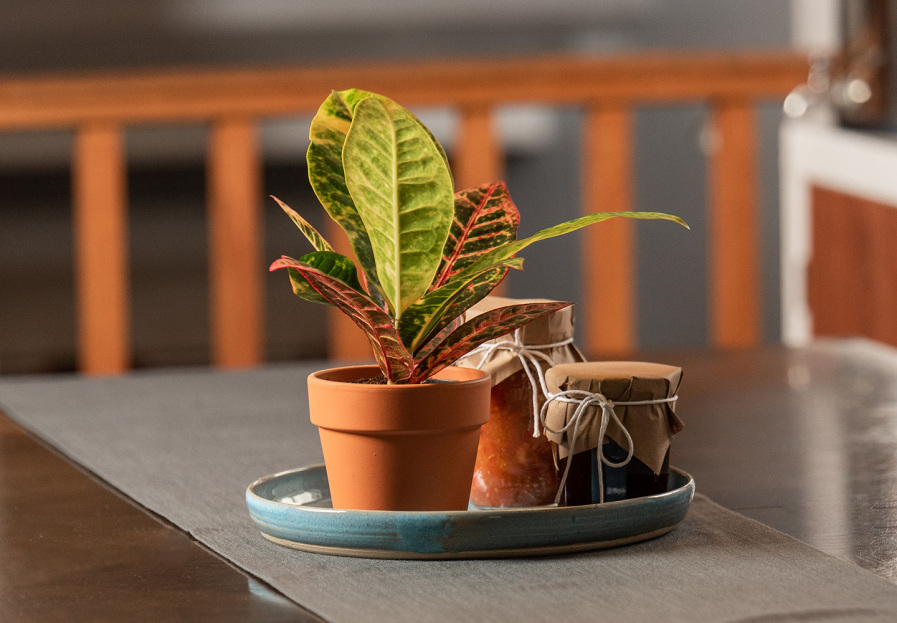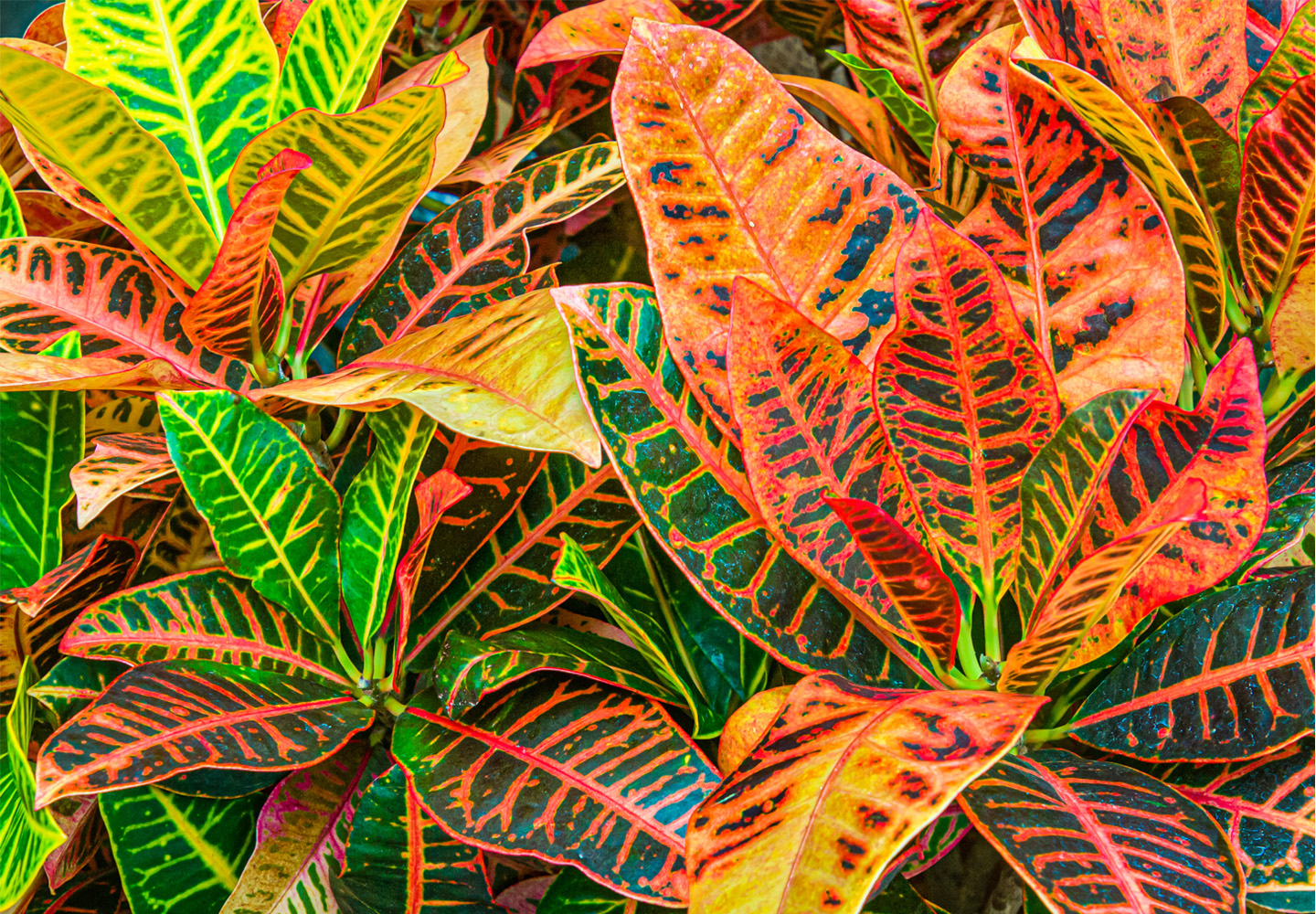
Fall in love with Crotons! Croton (Codiaeum variegatum) is an easy to grow and easy to care for tropical houseplant known for its beautiful, variegated foliage that boasts green, orange, yellow and red colours throughout its leaves.
These special plants are from the rainforests of Southeast Asia and Oceania. To keep them healthy, it's best to give them a climate and care like their natural habitat. This will help them stay vibrant and beautiful.

Croton plants enjoy a fair amount of sun. Giving them Bright indirect sunlight is where they do best. The more sun that you expose your plant to, the more its leaves will show its variegation and colored leaves.
If the new leaves of your plant are staying green, it means it needs more sunlight. You should move it to a spot with more sunlight, such as a south or east facing window. This will help increase the chances of its leaves becoming variegated and showing its beautiful colours.
Croton plants prefer to be in a well-draining moist soil. They prefer soil that is slightly acidic. Use a standard potting mix for houseplants with peat or sphagnum moss, coco coir, and perlite for best results.
Water your Croton plant once a week in the summer and every two weeks in the winter to keep it healthy. If you notice the plants leaves start to droop, then this is a sign that your plant needs a bit more water. Be sure to discard any excess water sitting at the bottom of its pot after watering, to prevent root rot and reduce the chance of pests like spider mites.
A rule of thumb is to feel the top of the soil before watering, if your soil still feels moist then wait until the top few inches dry out before watering again.
Crotons are happiest at temperatures of about 15-25ºC (59-77ºF). Plants can handle temperatures slightly outside their preferred range for a short time. However, prolonged exposure to extreme temperatures can harm them. It’s also best to keep them away from being exposed to any hot or cold drafts from windows, air conditioners or heating vents.
Low humidity and temperature can affect its leaf colour. Keeping the humidity in the room between 40 – 80 % is ideal for this type of plant. If you want to increase the humidity you can lightly mist the plant leaves, run a humidifier, or place a humidity tray under the plant.
To increase the humidity, you can mist your Croton with a spray bottle or mister. Another key point is to always check the bottom of your pot to ensure there is no sitting water after you water your croton – as this can quickly lead to root rot and the death of your plant.
Croton plants can easily go into shock when they experience change. Changing its watering schedule too quickly or moving it somewhere with different light exposure can cause the plant to go into shock. When this happens your plant may start to loose some leaves. So be mindful when deciding to move your plant, it is best to slowly acclimate it to its new conditions before making the transfer of locations.
Once it gets some time to adjust to its new environment and changes – your plant will continue to grow as normal. Taking extra care of your plant now will help it recover and grow back to normal.
You should regularly feed crotons during their growing season with a liquid fertilizer diluted to half strength. However you should not do this more than once every 3 – 4 weeks. If you live in a northern climate, your croton plant will most likely become dormant during winter, so it is not recommended to fertilize it during this time.
Pruning is usually not necessary for Croton plants, however if its lower leaves have fallen off you can help encourage its growth by trimming these leaves off.
Propagating a Croton plant can be quite easy. The main factor when doing this is temperature.
The best method for propagating is via stem cuttings. Stem cuttings will encourage new growth and will maintain a consistent size.
1. Cut off the tip of the stem on your croton plant and stick it into soil to help them grow roots.
2. For a Croton to propagate successfully – they need to be in a warm and humid environment. Placing in a mini greenhouse environment or covering with a plastic bag or sheet can help create a humid environment for your cutting to grow healthy roots.
3. Once your cutting begins to grow roots and show signs of growth you can remove it from its humid environment and begin to care for it as normal.
Regular potting or repotting is not necessary for a Croton plant’s health. However, if you would like to stunt its growth you can limit this by keeping it in a smaller pot which will give it limited space to grow. On the other hand, if you want your Croton to continue to grow larger you can repot them into a pot that is slightly larger than its current one.
When you are repotting, gradually increase the size of the pot for the best results. Doing this incrementally will also reduce the chances of it going into shock. Also be sure to perform this repotting when the plant is healthy and during its growing season – as doing this while they are dormant will possibly result in your plant going into shock. Spring is typically a good time to repot crotons.
Croton plants can be toxic to cats and dogs and can also cause indigestion and/or stomach irritation if consumed. It is recommended to keep this plant out of reach of any curious children or pets.
If you notice your leaves are falling off on your croton this is a sign that you may need to water your plant more frequently. Once the top few inches of soil dry out you should give your Croton a thorough watering as they can be quite thirsty during their growing period.
Your Croton plant should be getting a fair amount of bright indirect sunlight. If you notice your plant’s new green leaves do not change colour then you can safely give your plant a bit more light to help encourage its variegation of it leaves.
In the wild Crotons can grow to a height of about 10ft, but Crotons grown indoors in containers will grow much more slowly and will remain more compact.
Croton plants are susceptible to pests such as spider mites, mealybugs, and scale insects. Inspect your plant regularly for signs of pests, such as webbing, sticky residue, or visible insects. Treat infestations promptly with insecticidal soap or neem oil.